|
|
|
Sort Order |
|
|
|
Items / Page
|
|
|
|
|
|
|
| Srl | Item |
| 1 |
ID:
132408
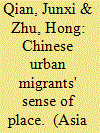

|
|
|
|
|
| Publication |
2014.
|
| Summary/Abstract |
In this paper, we study urban migrants' sense of place in Guangzhou, China, focusing on the structural relations between place attachment, identification and dependence as the three key place dimensions. Through both quantitative structural equation modelling and qualitative analysis of in-depth interviews data, our research suggests that migrants' sense of place demonstrates complex relationships between the three registers of emotional attachment, identity formation and functional dependence. The construction of sense of place is also related to the personal experiences of living as urban 'outsiders'. Our research also reveals a striking difference between the city and community levels in terms of the ways in which migrants' sense of place is constructed. Urban migrants tend to exploit the functional utilities of microscopic urban spaces to meet their demands for recreation, education and socialisation. On the other hand, their sense of place to the city is largely compromised by their attachment to the hometown and conditioned by their personal identification to the city.
|
|
|
|
|
|
|
|
|
|
|
|
|
|
|
|
| 2 |
ID:
133271
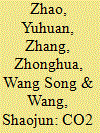

|
|
|
|
|
| Publication |
2014.
|
| Summary/Abstract |
In light of the growth in vertically specialized in global trade, the present paper uses input- output tables from the World Input-Output Database to construct an environmental multi-regional input-output model to calculate the CO2 emissions embodied in China's international trade during 1995-2009. The advantage of this model lies in its incorporation of the re-exported CO2 emissions component embodied in trade and its ability to differentiate domesticsourced CO2 emissions from foreign-sourced CO2 emissions in trade. The results show that carbon emissions embodied in both China's exports and imports increased significantly during 1995-2009. One important reason for this is that the re-exported carbon emissions embodied in China's imported intermediate inputs increased substantially during this period. Our research reveals that accelerating the transformation of trade pattern and upgrading processing trade should be emphasized in the formulation of policy to prompt CO2 emissions abatement in China.
|
|
|
|
|
|
|
|
|
|
|
|
|
|
|
|
| 3 |
ID:
128309
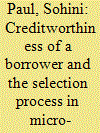

|
|
|
|
|
| Publication |
2014.
|
| Summary/Abstract |
This article examines whether urban micro-finance institutions (MFIs) consider proxy/hidden collateral in the absence of physical as well as social collateral in judging the creditworthiness of a borrower. MFIs operating in urban slums often adopt an individual lending mechanism since borrowers are not willing to bear joint liability due to the acute problem of migration. Therefore, urban MFIs that offer individual loans are extra-cautious about minimising default risk. This article studies whether MFIs consider ownership of a room in a slum as a hidden selection criterion in a loan programme. Room ownership indicates stability in a particular location, and also indicates the income-generation capability of an aspirant borrower. We use a primary survey database collected from a non-governmental organisation, Navnirman Samaj Vikas Kendra, which provides micro-credit in four slums of north Mumbai in India. We find that the probability of getting selected in a micro-credit programme is significantly higher if a loan applicant owns a room than if the applicant lives in a rented room. MFIs appear to be more concerned about shielding themselves from default than fulfilling the broad goal of maximising social welfare by reaching the poorest of the poor. We present our study with the caveat that the results may not be generalisable, since they are based on a case study.
|
|
|
|
|
|
|
|
|
|
|
|
|
|
|
|
| 4 |
ID:
133270


|
|
|
|
|
| Publication |
2014.
|
| Summary/Abstract |
China's rapid economic growth has been facilitated by its large volume of rural to urban migration. China's projected future development, especially increasing urbanization, implies that such migration will further intensify. However, migration does not come without cost. There are concerns about the potential negative impacts of migration on children's care, education, and, in particular, the self-esteem of children left behind in villages where one or both parents have out-migrated to cities. In this paper, we employ unique survey data collected from Shaanxi Province, where more than 4700 ninth grade students from 36 rural junior high schools in five counties were surveyed in late 2011. The results show that having both parents migrate into cities significantly reduced children's self-esteem. The effects are also gender sensitive. Girls that had a father or both parents who had out-migrated were inclined to have lower self-esteem than boys. Moreover, our study findings indicate that parental migration decreased children's self-esteem more for individuals with initial low self-esteem.
|
|
|
|
|
|
|
|
|
|
|
|
|
|
|
|
| 5 |
ID:
097329


|
|
|
| 6 |
ID:
069043
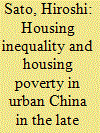

|
|
|
| 7 |
ID:
103853
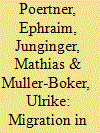

|
|
|
|
|
| Publication |
2011.
|
| Summary/Abstract |
In Nepal, international labor migration to India and overseas, as well as internal migration to the rural Nepalese lowlands, is of high socioeconomic significance. Scholarly debates about migration in Nepal have gradually shifted from an economic to a more holistic perspective, also incorporating social dimensions. However, little evidence has been generated about internal migration to urban destinations and the potential linkages between international and internal migration. This article draws on Bourdieu's "Theory of Practice" and sees migration as a social practice. Accordingly, migration practice is regarded as a strategy social agents apply to increase or transfer capitals and ultimately secure or improve their social position. Evidence for this argument is based on a qualitative case study of ruralto- urban migrants in Far West Nepal conducted in July and August 2009. The study at hand addresses linkages between internal and international migration practices and provides insight about a social stratum that is often neglected in migration research: the middle class and, more precisely, government employees. The authors show that social relations are crucial for channeling internal migration to a specific destination. Furthermore, they unveil how internal migration is connected to the international labor migration of former generations. Finally, the authors examine how migration strategies adopted over generations create multi-local social networks rooted in the family's place of origin.
|
|
|
|
|
|
|
|
|
|
|
|
|
|
|
|
| 8 |
ID:
131960


|
|
|
|
|
| Publication |
2014.
|
| Summary/Abstract |
This article looks at the changing frameworks for the institutional and cultural incorporation of second-generation rural migrants in Shanghai. Beginning in 2008, Shanghai launched a new policy of accepting migrant children into urban public schools at primary and secondary levels. I show that the hukou (household registration) is still a critical social boundary in educational institutions, shaping uneven distribution of educational resources and opportunities, as well as hierarchical recognition of differences between urbanites and migrants. I have coined the term "segmented incorporation" to characterize a new receiving context, in which systematic exclusion has given way to more subtle forms of institutional segmentation which reproduces cultural prejudice and reinforces group boundaries.
|
|
|
|
|
|
|
|
|
|
|
|
|
|
|
|
| 9 |
ID:
103863


|
|
|
|
|
| Publication |
2011.
|
| Summary/Abstract |
Many studies of the social backgrounds of terrorists have found that they are wealthier and better educated than the population from which they are drawn. However, studies of political behavior have shown that all forms of political involvement are correlated with socioeconomic status. Among those who are politically active, opportunity costs may lead those involved in nonviolent activities to have a average social status than violent individuals with a similar ideological orientation. This article develops a theory of participation in violence that incorporates both opportunity costs and informational barriers to participation and tests it by comparing violent and nonviolent political activists involved in the anticolonial agitation in Bengal (1906-39) using data from their police files. While the Bengali terrorists are better educated and have higher status jobs than the population average, they are less educated and less wealthy than the nonviolent activists. These results suggest that socioeconomic status may play a substantial negative role in terrorist recruitment within elites.
|
|
|
|
|
|
|
|
|
|
|
|
|
|
|
|
|
|
|
|
|